Family : Ephippidae

Text © Giuseppe Mazza

English translation by Mario Beltramini
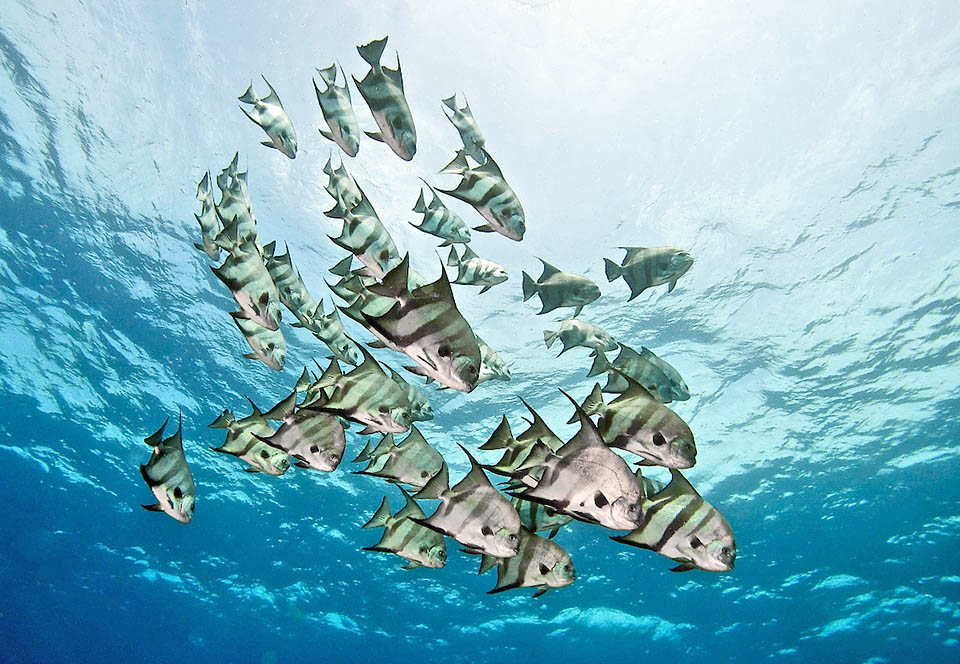
Chaetodipterus faber is present in the tropical and subtropical waters of west Atlantic, from southern Massachusetts up to all Brazil © Allison & Carlos Estape
Chaetodipterus faber (Broussonet, 1782) belongs to the class of the Actinopterygii, the ray-finned fishes, to the order of the Acanthuriformes and to the family of the Ephippidae like the analogous Platax teira, often guest of the large public aquaria, who lives in the tropical Indo-Pacific.
Chaetodipterus comes from the genus Chaetodon, the one of the butterflyfishes, with the addition, in Greek, of
“di”, two, and “pterus”, fin, because in respect to the butterflyfishes the dorsal fin, especially in the last juvenile phase, appears as divided in two.
The specific term faber has not been explained and is not evident. In Latin, it means blacksmith, carpenter, craftsman, and so also skillful.
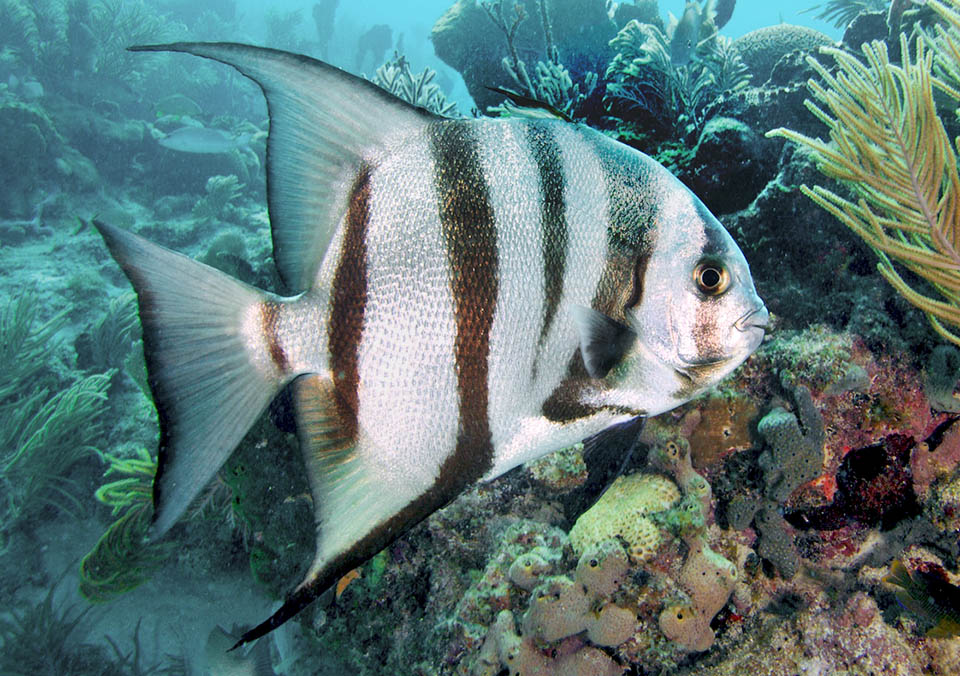
The body, usually half a metre long with a record of 90 cm, is almost discoid, very compressed, silvery, grooved by 6 vertical black bands © Allison & Carlos Estape
Zoogeography
Chaetodipterus faber is present in the tropical and subtropical waters of western Atlantic, from southern Massachusetts and the Gulf of Mexico to the Caribbean and then all Brazil up to Rio Grande do Sul.
Ecology-Habitat
It is a fish that goes swimming mainly in shallow waters, between 3 and 35 m in depth, going exceptionally up to about 90 m.
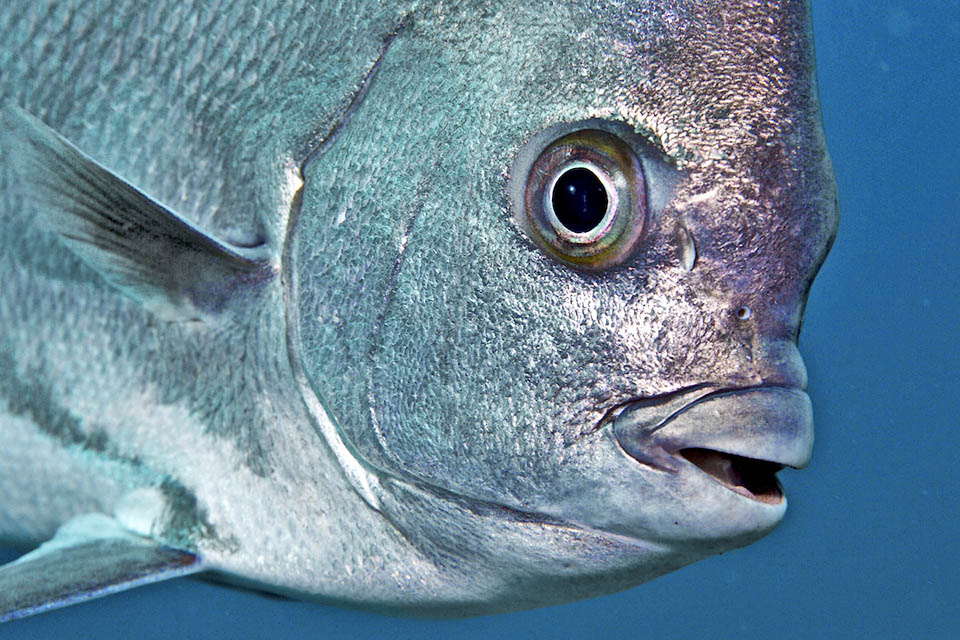
The profile shows a slight swelling at the eyes level and the mouth is small with bands of brush-like teeth © Allison & Carlos Estape
It is often found along the coasts, in the brackish lagoons and in the harbours, but also offshore in large schools that may count 500 individuals, and lets, without fear, the divers to approach it.
Usually the juveniles grow up in the estuaries and the formations of mangroves where, thanks to its dark livery, swimming at an angle, the predators often mistake them and consider them dead leaves.
Morphophysiology
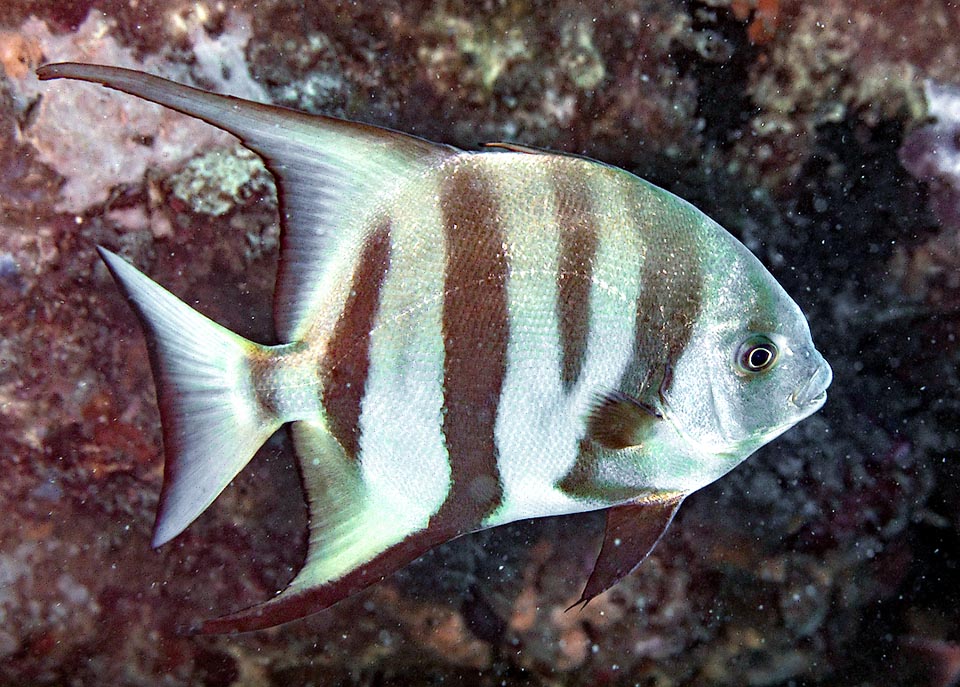
In fact it eats plankton, but also small crustaceans, especially amphipods, mollusks, jellyfishes, annelids and cnidarians © Allison & Carlos Estape
Chaetodipterus faber may exceptionally exceed the length of 90 cm, but the current size is of about half a metre.
The very compressed body forms almost a disk, with short and blunt snout. The mouth is small with bands of brush-like teeth absent on the palate. As a matter of fact, it feeds on plankton and on modest-sized invertebrates, such amphipods, mollusks, jellyfishes, annelids and cnidarians.
The dorsal fin has 9 low spiny rays and 21-24 soft. The third spine, higher, marks a clear break with the soft ones. The anal has, like all Ephippidae 3 spines, followed by 17-19 unarmed rays.
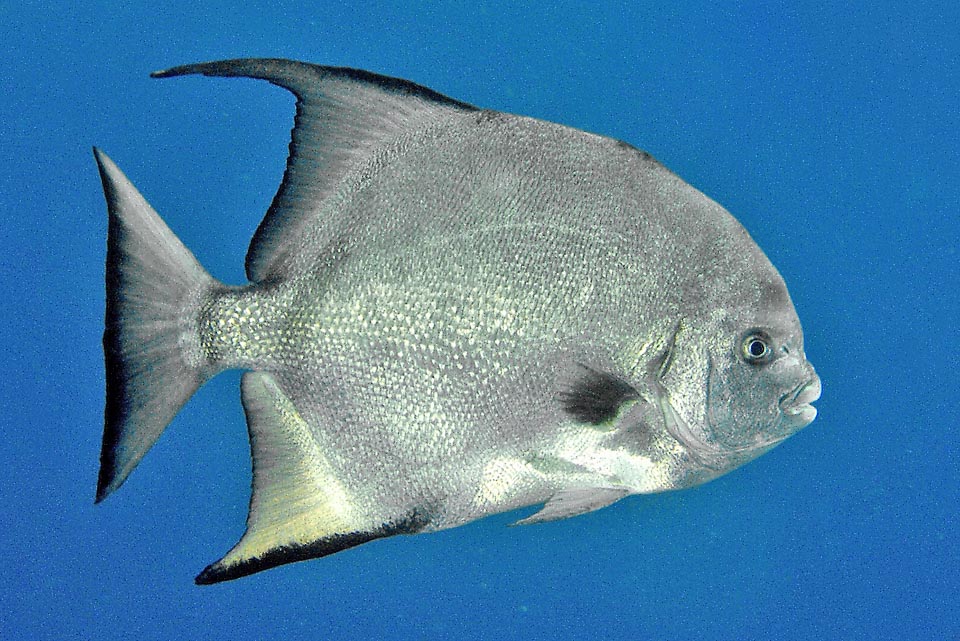
Growing, the black bands fade until they disappear in the big adults. Conversely remains the typical black spot at the base of the pectoral fins © Allison & Carlos Estape
The caudal is more or less truncated. The pelvic ones are sharp, and the pectoral, with 17-18 soft rays, are characterized by a dark spot at the base forming a sort of fake eye well visible in the old adults when the typical vertical black bands on silvery background have now disappeared.
The livery of the subadults and of the juveniles of Chaetodipterus faber in fact displays a dark band crossing the eye, followed a more conspicuous one at the level of the opercle, a short third and again a large one that seems to break in two parts the body. The fifth begins in the middle of the soft dorsal rays and the last stand at the end of the caudal peduncle.
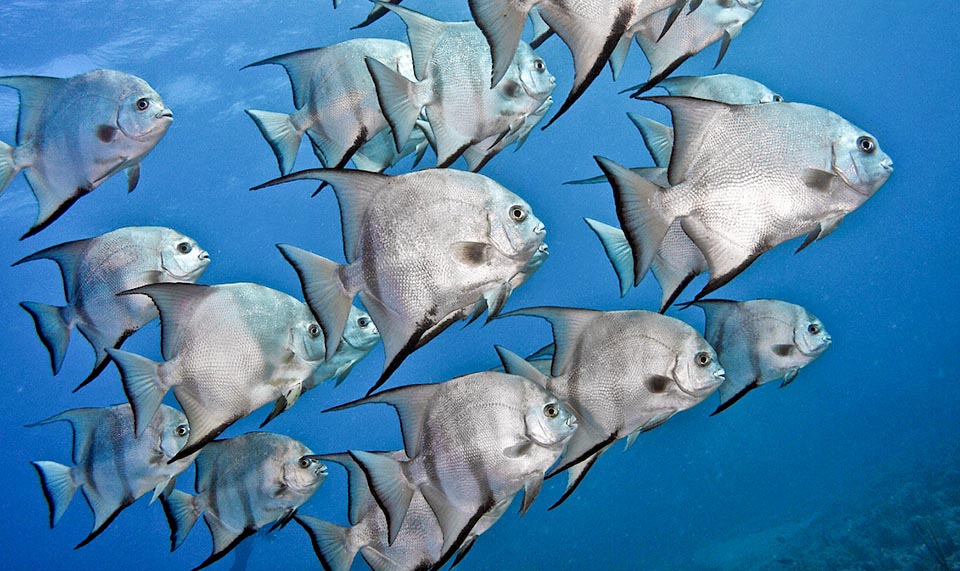
Adults often merge in large schools with even 500 individuals. Reproduction occurs in open seas with eggs entrusted to the currents © Allison & Carlos Estape
Ethology-Reproductive Biology
Chaetodipterus faber lives about 8 years. Females reach sexual maturity when one year old, at about 13-14 cm of length, and the males even before.
The reproduction occurs offshore between May and October, and one single female may spawn on several occasions even one million of eggs per season. They are entrusted to the currents and hatch after 24 hours.
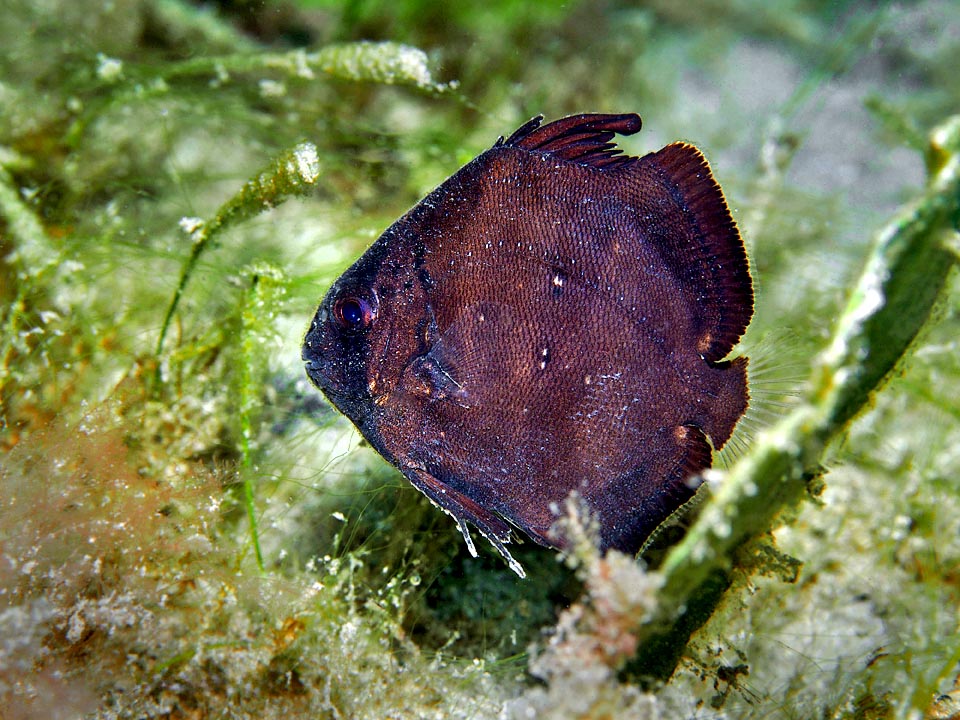
Juveniles grow in the estuaries and the mangroves formations. Their livery is dark and swimming often at an angle they seem dead leaves © Pauline Walsh Jacobson
The larvae, once the yolk is consumed in a couple of days, feed on plankton.
As already mentioned, at the beginning the juveniles are blackish. Then, in an intermediate phase, the bands appear and gets well visible the separation between soft and spiny rays of the dorsal.
The smoked or grilled flesh of Chaetodipterus faber is considered as excellent, although rare cases of ciguatera poisonings have been reported. It is caught on the line, with clams attached to circular hooks, and is bred for consumption and for the aquaria, even if, growing up, may be hosted only in the large pools of the public ones.
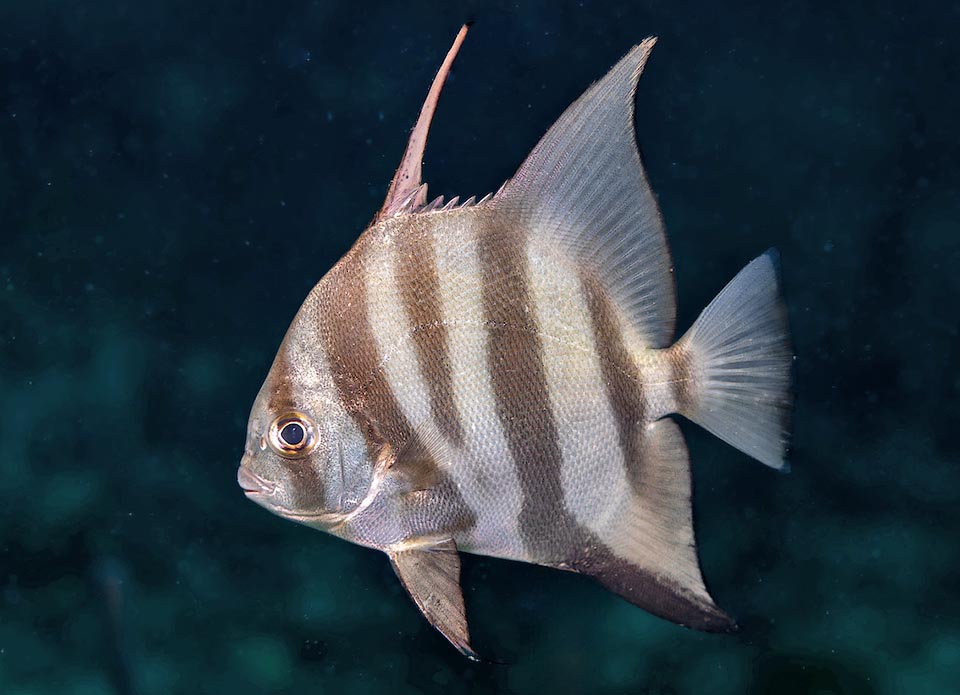
In this intermediate liver are well visible the mimetic vertical bands and the separation between soft and spiny rays of the dorsal fin © Allison & Carlos Estape
The resilience of the species is mediocre, with a possible doubling of the populations in 1,4-4,4 years and the fishing vulnerability marks 49 on a scale of 100.
Even if in some places the populations are declining, Chaetodipterus faber globally is not endangered and appears consequently as “LC, Least Concern”, in the IUCN Red List of the endangered species.
Synonyms
Chaetodon faber Broussonet, 1782.
→ For general information about FISH please click here.
→ For general information about BONY FISH please click here
→ For general information about CARTILAGINOUS FISH please click here.
→ To appreciate the BIODIVERSITY of BONY FISH please click here.
→ To appreciate the BIODIVERSITY of CARTILAGINOUS FISH please click here.
